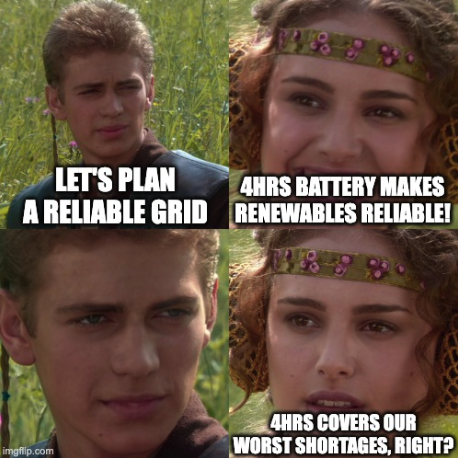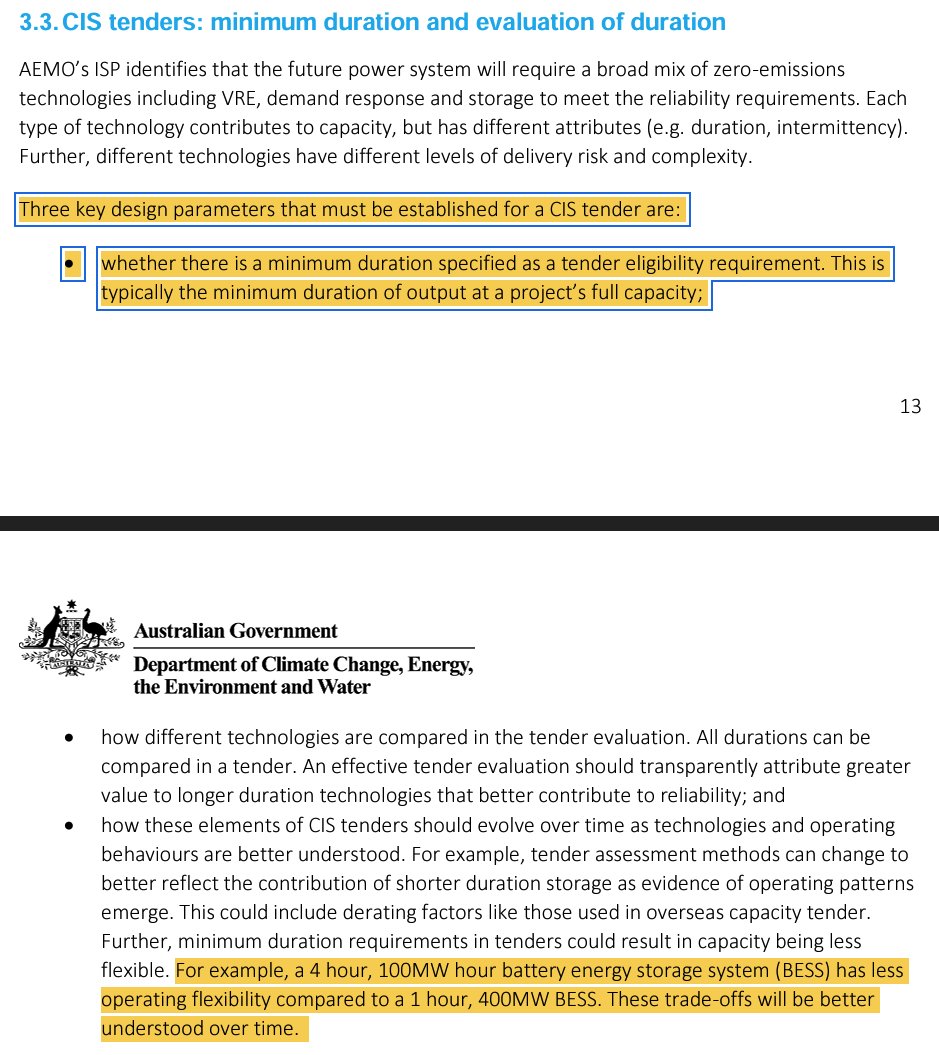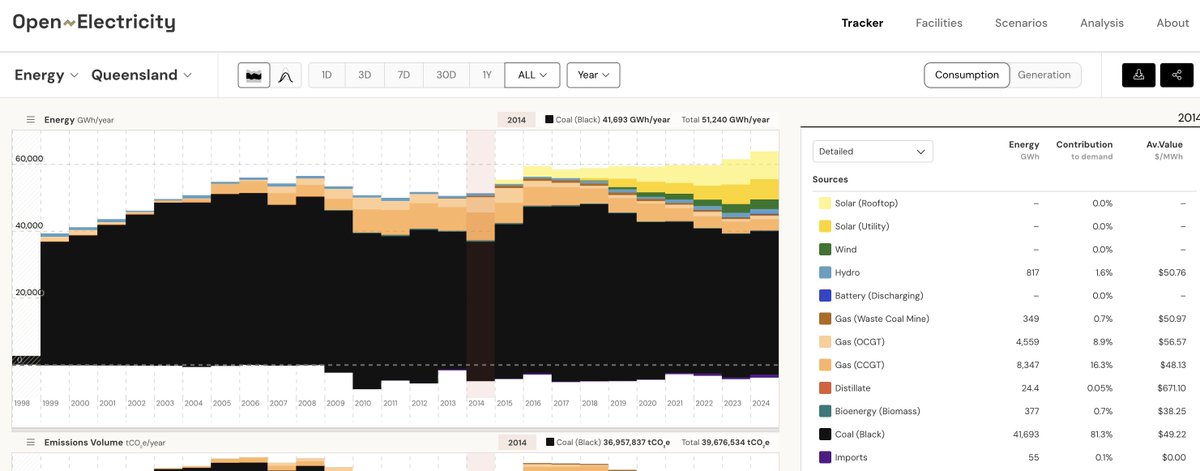Time for a 🧵on the Capacity Investment Scheme (CIS), and this rather massive expansion.
Big expainer coming.
Let's start with what appears to be a proud announcement that something 'equivalent to half the current NEM' requires government Subsidies 1/
Big expainer coming.
Let's start with what appears to be a proud announcement that something 'equivalent to half the current NEM' requires government Subsidies 1/
https://twitter.com/Bowenchris/status/1727492033403904473
This is a picture-perfect snapshot of the naivety that will be our undoing.
32GW total 'capacity'.
Only 23GW generating (the rest just storing)
And that 23GW on average generating at 30% capacity.
It doesn't/won't power anything like half our grid. 2/
aer.gov.au/industry/regis…


32GW total 'capacity'.
Only 23GW generating (the rest just storing)
And that 23GW on average generating at 30% capacity.
It doesn't/won't power anything like half our grid. 2/
aer.gov.au/industry/regis…


But to get back to the CIS and it's ambition, we need to understand it's primary objective... Ensure enough 'dispatchable' (ie controllable, you can turn it on when needed) capacity to retire coal.
And initially, it's all about storage. 3/
And initially, it's all about storage. 3/

The best description of the CIS comes from the Consulatation Paper.
Note 'clean dispatchable capacity'. Wind and solar aren't that. Only batteries (charged up) can be switched on. Until they run out.
Also note 6GW, from AEMO's ISP. For reliability. 4/
energy.gov.au/government-pri…

Note 'clean dispatchable capacity'. Wind and solar aren't that. Only batteries (charged up) can be switched on. Until they run out.
Also note 6GW, from AEMO's ISP. For reliability. 4/
energy.gov.au/government-pri…

Now it's pretty easy to see where they got 6GW from in the ISP (Integrated System Plan). It's the utility-scale storage. If you add Short and Long to Medium around 2030, you get a touch over 4GW for NEM. Add in WA, NT, 6 sounds about right. 5/ 

Now, apart from the assumption in the ISP that consumers buy just as much and make it available to the grid at no cost (Coordinated DER) 😠 the key takeaway here is that CIS, until Thursday is 100% for storage. No solar, no wind. This is (was) batteries. 6/
Not that there's any doubt about that, but it's certainly made abundantly clear in later sections. '4hr equivalents' is key, this is their chosen metric, not a strict specification. Happens to align with 'medium' which is the largest part identified by the ISP. 7/ 

In fact, further down you see them admit that they're not really sure about whether 4hrs is a minimum, an 'equivalents' metric, a guideline, a reference for derating value, or what. It is (or was) still being figured out. 8/ 

Also uncertain: the modelling used to establish what target (in terms of capacity) is required to actually make the grid reliable.
They start out saying 6GW comes from the ISP, which sounds like ALL of the utility-scale storage... But then they expect more... 9/
They start out saying 6GW comes from the ISP, which sounds like ALL of the utility-scale storage... But then they expect more... 9/

But then they go on to say a different document, which is more reliability focussed (the ESOO) will be somehow involved, and the exact system/method is still to be figured out.
And that they'll publish it eventually. 10/
And that they'll publish it eventually. 10/

In fairness, this is a consultation document, consultations closed end of August. Having some things to figure out is ok.
But knowing what they are still figuring out, and what the initial proposed concept was, is crucial context when something gets radically changed. 11/




But knowing what they are still figuring out, and what the initial proposed concept was, is crucial context when something gets radically changed. 11/




So what is (was) the initial concept? (And it's crucial to remember here that we're talking batteries).
It's a guarantee of 'net revenues' above a floor. Not a minimum price for wholesale price (which I might have understood).
Paid quarterly, annual true-up. 12/



It's a guarantee of 'net revenues' above a floor. Not a minimum price for wholesale price (which I might have understood).
Paid quarterly, annual true-up. 12/



Also, the other side is that there's a 'ceiling' where the reverse happens. If the batteries make a killing, they have to give back some of it.
Crucially, all these thresholds and percentages are variables to be determined in bids. Unknown to us. 13/
Crucially, all these thresholds and percentages are variables to be determined in bids. Unknown to us. 13/
The final piece of the puzzle is the 'performance requirements'.
This is crucial. 50% capacity must be bid in a LOR3 (or blackout) forecast with 2 hours notice. (Which is what would happen for a bad weather spell for renewables.) 14/


This is crucial. 50% capacity must be bid in a LOR3 (or blackout) forecast with 2 hours notice. (Which is what would happen for a bad weather spell for renewables.) 14/


And now we can see the fundamentals of CIS.
A battery makes money by buying energy when the price is low, and selling when high.
They'll maximise 'net revenue' by doing that as much as they can, over as big a price gap as they can. 15/
A battery makes money by buying energy when the price is low, and selling when high.
They'll maximise 'net revenue' by doing that as much as they can, over as big a price gap as they can. 15/
Now, starting with the massive caveat that most batteries are too small to do what I'm describing, and make most of their money providing other niche services that aren't just bidding in more power at good times... 16/
Eventually, it will be in the interests of very big batteries to discharge almost all of their capacity during basically every evening peak, having charged it that day at low prices when the sun was up. It will be even more the case in future with more solar. 17/
So operated commercially, often batteries will be empty.
And it will also be in the interest of batteries to sell all they have at the highest point of the peak. And peaks are often narrow. So batteries of 1-2hrs are currently the most commercially viable. 18/
And it will also be in the interest of batteries to sell all they have at the highest point of the peak. And peaks are often narrow. So batteries of 1-2hrs are currently the most commercially viable. 18/

So what the CIS is really trying to achieve is to keep their batteries charged for an emergency. And lose lots of revenue from when they could have bid it into the grid for a profit to reduce wholesale price peaks. 19/
This exposes the inevitable trade-off.
Batteries can help reduce average prices by moderating short-term fluctuations in demand/supply. Out-bid other fossil firming (diesel). Arguably they'd be good at that.
Or they can be held in reserve for an emergency. 20/
Batteries can help reduce average prices by moderating short-term fluctuations in demand/supply. Out-bid other fossil firming (diesel). Arguably they'd be good at that.
Or they can be held in reserve for an emergency. 20/
But not both.
What the CIS is trying to do is to push them towards being held in reserve for emergency.
Which I don't think they'd be good at, for the obvious reason that they might still run out before the weather turns good.
4hrs has no special hold on bad weather. 21/
What the CIS is trying to do is to push them towards being held in reserve for emergency.
Which I don't think they'd be good at, for the obvious reason that they might still run out before the weather turns good.
4hrs has no special hold on bad weather. 21/
So what Bowen is trying to do is attempt to get enough 'firm' capacity to permit coal to close.
By incentivising battery operational behaviour that will not put downward pressure on prices (as much as it might) and probably not give guaranteed availability in bad weather. 22/
By incentivising battery operational behaviour that will not put downward pressure on prices (as much as it might) and probably not give guaranteed availability in bad weather. 22/
Now the essence of the trade-off I've described is not controversial. In their own briefing documents to Industry, they acknowledge it will drive up cost of bids. (red square my own) 23/ 

But what I want to draw attention to is the assumption that this will be sufficient to meet reliability requirements.
Exactly how (did) we know that 6GW of 4hrs was enough to keep us on track?
Here, it's the transcript of a consultation webinar that has the gems. 24/
Exactly how (did) we know that 6GW of 4hrs was enough to keep us on track?
Here, it's the transcript of a consultation webinar that has the gems. 24/
Brad Hopkins (General Manager - Commercial, AEMO Services) tells us that ISP modelling underpins the choice of 4hrs, and that's not being served by commercial investments.
He also references ESOO modelling to predict 'contribution to unserved energy events'. 25/
He also references ESOO modelling to predict 'contribution to unserved energy events'. 25/

But later in the webinar, we end up circling back and back to these question of why 4hrs, 6GW, and the trade-offs between minimum capacities, how it will be determined etc.
TLDR: they're not sure, and are figuring it out. Open to feedback.
Btw, full panel: 26/
TLDR: they're not sure, and are figuring it out. Open to feedback.
Btw, full panel: 26/

Here's the first time the 'why 4hr' question is asked. (With a clear reference to 'the issue of perfect foresight'. 👀).
Zoe starts by affirming 4hrs Minimum. Methodology to emerge valuing more.
Salim contradicts. Not sure about the 4hrs. That's just the 'flavour'. 27/




Zoe starts by affirming 4hrs Minimum. Methodology to emerge valuing more.
Salim contradicts. Not sure about the 4hrs. That's just the 'flavour'. 27/




Then later, it's asked of Brad, who hand-balls back to Salim.
Credit to Salim, he gets that MW capacity hours duration are poor metrics for batteries. (MWh are better... A topic for another thread).
ISP common touchstone.
Zoe confirms she's open to suggestions. 28/



Credit to Salim, he gets that MW capacity hours duration are poor metrics for batteries. (MWh are better... A topic for another thread).
ISP common touchstone.
Zoe confirms she's open to suggestions. 28/



But the biggest bombshell comes from this question, about ISP, and how it'll change to incorporate the needs of the CIS.
Wait what?? The ISP, which we relied upon for the 6GW estimate, isn't sufficient?
Zoe starts with the timing being slow. And then... 29/
🥁🥁🥁🥁🥁
Wait what?? The ISP, which we relied upon for the 6GW estimate, isn't sufficient?
Zoe starts with the timing being slow. And then... 29/
🥁🥁🥁🥁🥁

💣💣💣🧨🧨🧨Booommm!!
Read every word.
Zoe is my new favourite public servant.
The ISP doesn't, never did, wasn't intended to, model a reliable electricity system.
And AEMO modellers are 'clear-eyed' about that.
CIS reliability needs is 'throwing up issues'.
30/
Read every word.
Zoe is my new favourite public servant.
The ISP doesn't, never did, wasn't intended to, model a reliable electricity system.
And AEMO modellers are 'clear-eyed' about that.
CIS reliability needs is 'throwing up issues'.
30/

This is obvious to anyone who's deeply familiar with the ISP methodology. They overfit capacity to a particular weather sequence. Which means that the installed capacities bounce around.
As I've said before. 31/
As I've said before. 31/
https://x.com/QuixoticQuant/status/1712647611612881222?s=20
But now I've found a public servant saying as much, and that she thinks the ISP needs to be modified in accordance.
"We all need to kind of be judicious..." Amen!
Excuse me for basking in the moment. This feels like a curtain call for me. I'd like to take a bow. 🙇♂️
32/
"We all need to kind of be judicious..." Amen!
Excuse me for basking in the moment. This feels like a curtain call for me. I'd like to take a bow. 🙇♂️
32/

And... @AEMO_Energy. What have they done?
They've been the opposite of 'judicious' in choosing modeling for a particular purpose.
They explicitly said they modelled the costs of the whole system (which it doesn't). And that system won't be reliable. Who knew? 33/
They've been the opposite of 'judicious' in choosing modeling for a particular purpose.
They explicitly said they modelled the costs of the whole system (which it doesn't). And that system won't be reliable. Who knew? 33/

@AEMO_Energy Now, with that in the foreground, I hope it's simple to see why the 6GW has been upgraded to 9GW of storage.
6GW was a finger-in-air estimate from the ISP, which was never fit to support reliability requirements.
Now they're starting to look harder, requirements grow. 34/
6GW was a finger-in-air estimate from the ISP, which was never fit to support reliability requirements.
Now they're starting to look harder, requirements grow. 34/
@AEMO_Energy But, in case that isn't enough of a monumental admission that the energy transition is failing, and every plan we thought we could rely upon we can't...
The really big change to the CIS is now they've expanded it to include variable (unreliable) generators aswell! 23GW! 35/
The really big change to the CIS is now they've expanded it to include variable (unreliable) generators aswell! 23GW! 35/
@AEMO_Energy This is profound because the commercial arrangement that they've outlined for batteries (which I think might be inefficient, opaque, generally not good) is positively disastrous for intermittent generators.
For one simple reason... 36/
For one simple reason... 36/
Canibalisation.
Make sure you follow @JomauxJulien for some great work on this.
The more renewables you add to a system, the less each one of them earns.
Because they produce at the same time, and drive prices down, eventually to zero. 37/
Make sure you follow @JomauxJulien for some great work on this.
The more renewables you add to a system, the less each one of them earns.
Because they produce at the same time, and drive prices down, eventually to zero. 37/
https://x.com/JomauxJulien/status/1727367304676041138?s=20
@JomauxJulien So whereas batteries, in a system of increasing renewable penetration, might plausibly have had increasing opportunities to earn, and less frequently hit the revenue floor, driving wind and solar in with the same mechanism is literally a blank check. 38/
@JomauxJulien To be honest, the whole concept of 'net revenue' (which makes sense for batteries, since they buy the power to charge, so there's an obvious cost to net off) doesn't apply at all well to generators.
The whole mechanism needs to be re-worked and re-consulted. 39/
The whole mechanism needs to be re-worked and re-consulted. 39/
@JomauxJulien And costing the exposure to the taxpayers is near-impossible.
To close, a few quotes from Kirsty Gowans at the consultation back in August.
All was foreshadowed. This scheme was going to be a 'whatever it takes' for a "momentum shift in renewable energy investment". 40/40



To close, a few quotes from Kirsty Gowans at the consultation back in August.
All was foreshadowed. This scheme was going to be a 'whatever it takes' for a "momentum shift in renewable energy investment". 40/40



@JomauxJulien @threadreaderapp unroll
• • •
Missing some Tweet in this thread? You can try to
force a refresh
















